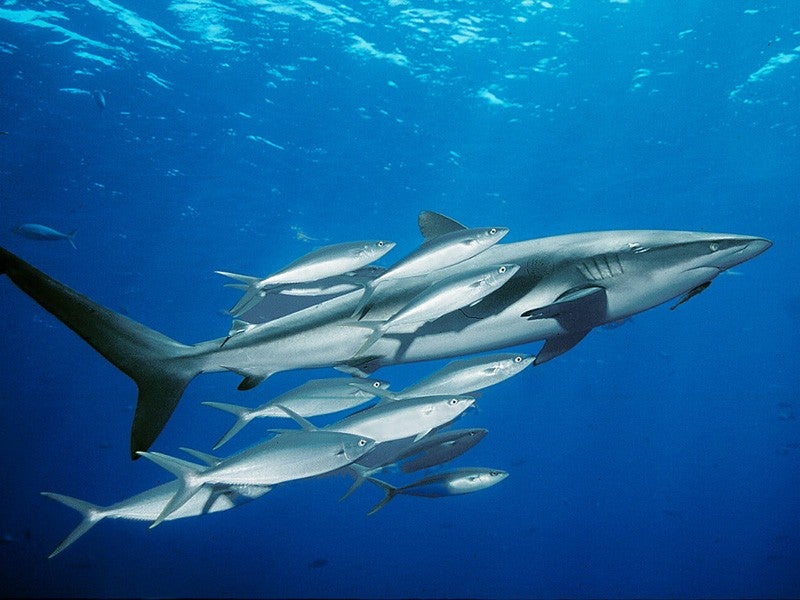Dusky Sharks Snatch Victory as Courts Tire of Trump Antics
Recent court rulings are the latest sign that Trump’s efforts to weaken critical environmental regulations are no match for the law.

This page was published 5 years ago. Find the latest on Earthjustice’s work.
Dusky sharks may be one of the lesser-known shark species. What they lack in name recognition, however, they make up for in all-around astonishing behavior. When they’re not busy eating other sharks, these 400-pound silver behemoths are known to migrate thousands of miles around the world.
But even an apex predator needs protecting. Though dusky shark fishing was outlawed in 2000, many duskies still get caught up — and killed — in longline gear that targets other fish. This is known as “bycatch,” and so far government regulators have refused to do much about it. As a result, the dusky shark population is now just a fraction of what it was before the 1980s.
That’s bad news for lovers of Shark Week — and for the ocean ecosystem. Similar to grizzlies and wolves, dusky sharks sit atop the food chain, where they help maintain the marine environment by eliminating sick or weak prey. Without these sharks, this delicate, watery web begins to unravel.
Thankfully, a federal judge in D.C. ruled recently that the National Marine Fisheries Service violated the law by failing to use all available scientific evidence to end the overfishing of dusky sharks in U.S. waters. The ruling, in response to a lawsuit filed by Earthjustice, requires regulators to do more to end the rampant overfishing that has plagued this formidable species for years.
Our argument in the dusky shark case was essentially this: Despite knowing for almost 20 years that excessive bycatch was preventing the dusky shark population from recovering, the agency had yet to place a definite, enforceable limit on the number of sharks caught and killed as bycatch. The agency also used faulty, incomplete data to come up with the number of sharks it thinks are caught as bycatch, ignoring the data fishermen recorded in their own logbooks. And it offered no scientific evidence that its proposed recovery measures would actually reduce the amount of bycatch overall.
In his ruling against the Trump administration, the judge had some harsh words for the fisheries service’s disregard for science. Instead of the agency refusing to use the fishermen’s logbooks, he wrote, “[the] rational response would have been to use one data source to complement, corroborate, and correct the findings of the other.” In fact, the agency has used fishermen’s records to monitor dusky sharks in the past, but it “hardly bothers to explain its inconsistent treatment of logbook data,” wrote the judge. Finally, as to why the agency simply ignored this valuable data source this time around, “The court is left scratching its head.”
This ruling is just the latest signal that courts have reached their limit with the Trump administration’s anti-science antics. Earlier this year, the fisheries service received another court-ordered smackdown after a federal judge ordered the agency to issue a scientifically valid catch limit for the anchovy population within 90 days. The ruling comes after years of the service stalling on this issue by using both woefully outdated population numbers to determine a proper catch limit and by sticking new, more accurate catch data in endless internal review.
The anchovy, though admittedly less dazzling than the dusky shark, is just as ecologically important. These tiny creatures are like the energy bars of the sea, serving as food for larger species like whales and sea lions. After anchovy and sardine populations both hit dramatic lows, thousands of starving sea lions began washing ashore in the San Francisco Bay Area in 2013.
Despite this tragedy, the agency proposed a catch limit in 2016 that could have exceeded existing estimates of the entire anchovy population. That’s like proposing to give someone 10 dollars when you only have five. Earthjustice challenged the wildly flawed proposal, and the judge ruled in our favor in January 2018, confirming that the agency must use the best available science when establishing a proposed catch limit.
Throughout the case, the agency displayed a startling resistance to replacing its stale, 30-year-old assumptions with current, perfectly good scientific data. At one point, the agency insisted to the judge that it didn’t have updated data on anchovy abundance, only to “find” it later. Even after the court issued multiple rulings invalidating the agency’s catch rule and requiring it to come up with a new one, the agency continued to drag its heels. It even tried to keep the public from commenting on the new rule the court ordered it to produce.
In the latest ruling, the court signaled its discontent with the agency, threatening to sanction it if regulators “continued a pattern of bad faith” by exhibiting behavior that showed they “had no intention of complying” with the ruling. Earthjustice attorney Andrea Treece, who’s been working for years to protect marine species, says that the threat of sanctions is pretty rare.
“It shows how fed up the courts are with this agency,” she adds. And, with climate change causing more drastic and unpredictable changes in ocean conditions, it’s only going to get worse. “It’s time to step into the 21st century and take care of our ecosystem.”
Jessica is a former award-winning journalist. She enjoys wild places and dispensing justice, so she considers her job here to be a pretty amazing fit.
Earthjustice’s Oceans Program uses the power of the law to safeguard imperiled marine life, reform fisheries management, stop the expansion of offshore oil and gas drilling, and increase the resiliency of ocean ecosystems to climate change.
